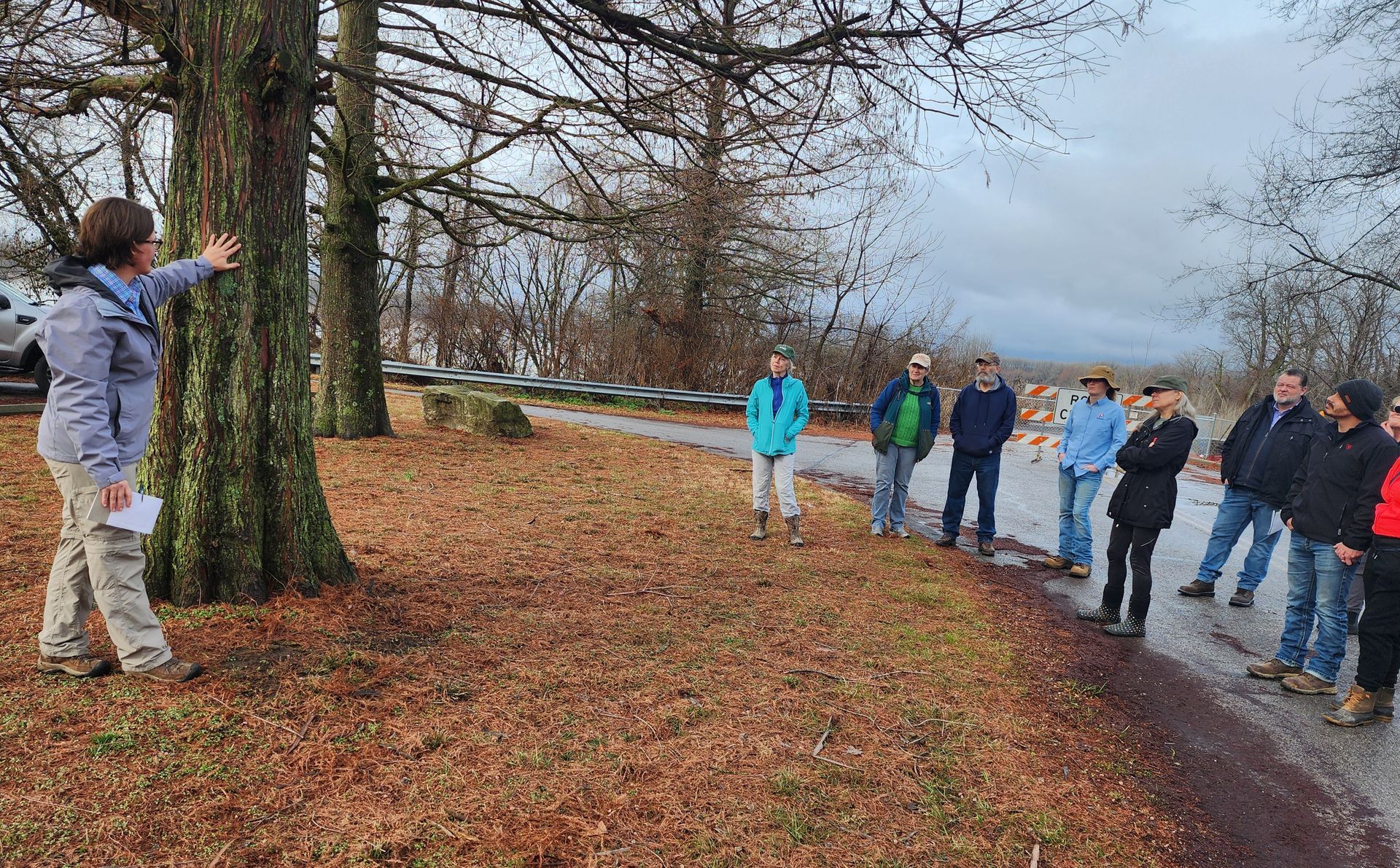
A morning tree walk.

A Morning Tree Walk
By Bob Hill, Guest Writer
Oh, to be three-and-a-half-year-old Anola Bezuska and be stomping around in a big fat puddle of water wearing a light blue dress and bright yellow boots.
Her stomp location was Origin Park. The occasion was a park-sponsored winter walking tour to identify – and discuss – its many and diverse trees as well as the larger vision for the 430-acre park just across the Ohio River from Louisville.
Its history includes being the site of the first town in the entire Northwest Territory. Adjacent to the Falls of the Ohio State Park, its footprint includes the launch site of the Lewis and Clark Expedition.
Anola Bezuska wasn’t yet aware of all that. She had her puddles, her three-year-old sense of innocent adventure and her mom, Cara Bezuska, along on this expedition. But many of the 25 adults who joined them in the walk were there to enjoy the park’s history and learn of its welcoming future.
Our winter tree tour guide was Renee Frith, who carries the heavy title of Director of Horticulture and Sustainable Landscapes at Bernheim Arboretum and Research Forest with a light, knowledgeable, and perfect-pitch delivery. She knows her stuff.
We gathered at the future site of the Origin Park Event Center, currently a garage painted in a bright, sprawling yellow-and-blue landscape featuring a canoe paddler and a bison. The weather was walkable. A streaky gray-and-blue sky in the mid-50s, following a thunderstorm that busted through the night before. Dealing with the bad news first, Frith led us to the inevitable clumps of invasive euonymus and honeysuckle that all parks deal with and spoke of methods of eradication.
Headed down toward the river we paused near a hackberry tree as Frith spoke of its high sugar content, thick root system, messy leaves and dark berries birds love. Not a good front yard tree, but useful in the grand scheme of nature. We paused at a bald cypress, a tree that prefers wet but can adapt to dry and is valued because it will grow straight up. We wandered past a black gum tree, a multi-tasking native that can live hundreds of years and has shiny green leaves in the summer that turn scarlet red in the fall. Add in flowers that pull in the honeybees and fruit enjoyed by songbirds, turkeys, and deer, and it’s a front or back yard keeper.
We paused at a tree that had recently been cut down as Frith explained how wounded trees can heal themselves. She offered praise for good and needed arborists who can best help homeowners make decisions on when to drop a tree, or how to prune it. Then, with a stream of joggers, hikers and bikers moving past, we headed uphill to what was once the site of the George Rogers Clark cabin at the Falls of the Ohio State Park.
George Rogers Clark and his brother, William, made some lasting history in their day. In 1778 and 1779 George, at only 26, led the Virginia militia in capturing the British outposts of Kaskaskia and Vincennes in Illinois country which led to the British ceding that entire Northwest territory to the United States. Broke, mostly forgotten and in poor health, he lived in the cabin on the Indiana shore from 1803 until 1809 before suffering a stroke and moving to his sister Lucy Croghan’s home at Locust Grove in Louisville. William Clark was the second name up in the Lewis and Clark Corps of Discovery Expedition that explored and mapped the lands of the newly acquired Louisiana Purchase. The two men, old friends, began and recruited members for the trip at the Falls of the Ohio in 1803. Being at that spot, with the Ohio River flowing below, the pounding sound of water gushing in five-foot waves from a hydroelectric dam across the way, the sense of history is palpable here: literally at our very feet.
Anola Bezuska seemed to be doing very well, too. She was gamely walking hand-in-hand with her mom, breaking away to pick up sticks, playing hide-and-seek under her mom’s blouse, wandering off to where her thoughts were taking her. She nicely declined all interviews, only answering, “Yeah” when asked if she was having a good time.
On we went, stopping for what can politely be described as a sex education course when discussing the pollen-spreading proclivities of various oak, magnolia, and tulip poplar trees. One stop even included how certain beetles help spread the pollen, and birds help spread seeds. Tree hardiness also came up, with Frith pointing out how, with climate change, hardiness and range can change.
“The native range will shift over time,” she said.
We headed over to some birch trees and a discussion of exfoliating bark; nature changing its clothes as trees mature. We also talked about the unfortunate tendency to want neatness and perfection when nature has other ideas.
“Nature is perfect,” Frith reminded us, “we are the problem.”
History washed in again as we crossed the bridge over Mill Creek, the precise spot from which Lewis and Clark headed west on October 26, 1803, and returned to on November 5, 1806, with a whole lot of artifacts, memories, and stories to tell. Then it was down a slope through Buttonbush Woods with Anola and mom included, a brushy lowlands area where tourists might find warblers, turkey, deer, pileated woodpeckers, and, in season, fragrant, black locust tree flowers. Or even buttonbush.
On the far side of those woods, along Silver Creek, was the Croghan Launch Site. It’s just up from the Ohio River, a place where canoes, kayaks, and paddle boards can be carried down steps to the creek to float out into the Ohio. Rising above us was a monster pile of old debris and dirt slated to one day be part of the park. Alongside and below the pile were dilapidated summer cottages and rows of old abandoned cars left behind by previous landowners, also to be dealt with in good time.
But optimism lives here, along with a recent $37.5 million grant allocated by the State of Indiana toward creating an estimated $75 million Whitewater Adventure Center within the park suitable for Olympic qualifying events. It would also include zip lines, climbing walls and walking paths -- all of which someday might be of interest to Anola Bezuska, who at this point in the tour has taken off her bright yellow boots and is happily stomping more puddles in her socks, carrying her now dirty boots in one hand. With Mom’s help, she has agreed to accept a golf cart ride back to the starting point, but still pretty much refused any in-depth interviews.
“Was it fun?” she was asked.
“Yeah,” she answered.


